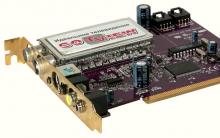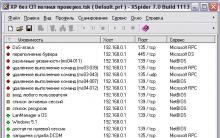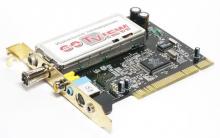Can you imagine a full-fledged work on a computer without connecting to a printer? Perhaps, being a gamer, the answer to this question can be given in the affirmative. Say what you like, but the lack of the ability to print documents does not affect the quality of games. Nevertheless, for those who like to work in Word, Excel and other text programs, having a working printing device at hand is not just important, but vital. Fortunately, such a pleasure is inexpensive today. However, it's not enough just to buy the right model, you still need to know how to install it correctly on your Windows 7 PC.
Overview of connection methods
Depending on the location of the printer and the actual access to it by the user, there are 2 options for installing this device on a computer with Windows 7, namely:
- connect it directly to the PC (local method);
- install over the network (network method).
Is it worth explaining when and what method should be used to connect? Is that so? Well then, let's explain it, it's a simple matter. In principle, already from the name of such methods, it becomes clear that the local method involves using the device for printing on only one computer, while the network method makes it possible to print documents on one device to users of several PCs.
Have you sorted it out? Fine! Then it only remains to figure out how to proceed with the local and network installation method on Windows 7.
Option # 1: Local connection
How do I install a printer using the local method on Windows 7? Very simple! It is enough to connect it via the USB bus to the computer. Note that if the Windows settings are correct, have not changed since the installation of the operating system, the connected equipment is recognized and installed on the PC automatically.
However, this trick is not always successful. What if, for example, an HP LaserJet 1010 printer is not installed on my computer? In this case, we act like this.
Step # 1: Connect to PC.
First, we connect the printer with a USB cable to the computer and turn it on to the network. Next, open the "Start" menu and select the "Devices and Printers" tab:

In the window that appears, find and click the "Printer Installation" tab:

Then we decide on the connection option. Do you want to install it locally? Have you changed your mind? Then we click the item "Add a local printer":

Next, select the printer port. In principle, it is better to leave everything as it is, unchanged, since the LPT1 port fully meets the installation requirements. This completes the connection. It remains only to make settings for its work. To do this, click on the "Next" button and go to the next step.

Step number 2: We make the settings for the printer.
What is the first thing to be done? First, install the driver. This can be done in three ways:
- using the installation disc;
- using the hardware installation wizard;
- via Windows Update:

Suppose that at the time of installing the HP LaserJet 1010 we did not have a disk with a driver for it, it cannot be installed, or we are using a computer without a drive. What do we do in this case? It would seem that everything is simple: you can install it from Windows Update. But it was not there.
There is no official driver for the HP LaserJet 1010 in Windows 7. In this case, there are 2 options:
- install it by downloading it from the Internet;
- select the driver for the HP LaserJet 3055 PCL5 in the installation wizard.
We will choose the latter option, as despite the difference in name, it is fully compatible with the HP LaserJet 1010:


Now all that remains is to decide on the parameters of access to the printer from other PCs. In this case, we either restrict it (the item "No sharing ..."), or allow typing on it ("Allow sharing ..."):

This completes the device configuration. It remains to check its work.
Step # 3: Checking the seal.
So, if all the steps for connecting and configuring were performed correctly, after selecting the parameters for accessing the printer, a window will appear with a message about its successful installation. Whether this is really so, we still need to check. How to do it? Click the "Print test page" button:

Everything works? Prints flawlessly? Then you can safely praise yourself! We did our best!
Option # 2: Network connection
Sorted out with local connection? Then installing a network printer in Windows 7 will not be difficult at all.
Step # 1: Connect and configure a network printer.
What are we doing? Through "Start" go to "Devices and Printers", click "Add Printer" and select the item "Add network ..." in the window that appears:

As a result, Windows 7 will automatically search for all printers connected to the network. What do we need? First, find out the name of the network printing device to which we have to connect. Learned? Then select the appropriate option and click "Next":

As a result, the computer will connect to the device and automatically install the drivers for it. What if it is not installed? Pay attention to system messages. Sometimes this process requires manual configuration. In particular, the "Install driver" button may appear in the window for setting up a network printer. By clicking on it, the problem will be eliminated by itself and the corresponding message will be displayed on the screen about the successful installation of the network printer:

Step # 2: Checking work
How can I check if my network printer is working? Print any document. It seems that everyone should cope with this, right? But what if the document was sent to print and did not print? This, we note, happens quite often. How to solve the problem? First, check the following settings:
- determine if the equipment is connected to the host computer;
- determine if there are any restrictions for such a network printer;
- check if it is connected to the network;
- one of the most common peripheral devices that are connected to a computer. Therefore, the process of installing and configuring printers raises a lot of questions. Most often, users are interested in how to install a driver for a printer. In fact, there is nothing difficult about it. In most cases, you just need to find a suitable driver and install it like a regular program.
The first thing to start with is finding the right ones. Each printer model has its own drivers, so you need a driver for your particular model. You can find such a driver in two places: on disk or on the official website of the printer manufacturer.
If you have a driver disc that came with your printer, you can install the driver from that disc. But, even if you have a disc, it is always better to download the drivers from the manufacturer's official website. The fact is that the drivers are regularly updated on the manufacturer's website. Therefore, by downloading such a driver, you get the most current version of the driver, in which all errors are corrected.
It should be noted that you need to download the drivers from the manufacturer's official website. It is better not to use unofficial sites that offer drivers for different equipment from different manufacturers. Because on such sites the drivers may be outdated or contain viruses.
It is very easy to find the driver you need on the official website. All you need to do is enter the full name of your printer into a search engine and go to the manufacturer's official website. Most likely, the link to the manufacturer's official website will be one of the first in the search results.
After going to the manufacturer's website, you need to find the section with drivers, select your version of the Windows operating system and download the installation file.
Installing Printer Drivers
The installation of drivers for the printer itself usually occurs in automatic mode and is not much different from the installation of conventional programs. You need to run the downloaded installer and then follow the instructions that will appear on the screen.

Before proceeding with the installation of drivers for the printer, it is advisable to turn on the printer and so that the installer, if necessary, can determine the presence of the printer. If this is not done, then during the installation of the drivers a window will appear asking you to turn on the printer and connect it to the computer. When the installer detects the printer, the driver installation continues.
After installing the drivers for the printer, restarting the computer is usually not required. The printer starts working immediately after installation.
How to install a printer on a computer, step by step.
Probably you want to know how to consistently earn on the Internet from 500 rubles a day?
Download my free book
=>>
If you decide to connect your activity with the Internet, then the printer is that important detail that must not be forgotten. When I was just starting my business, I was almost immediately faced with the need to install a printer.
And even now, hardly a day goes by when something needs to be scanned or sent to print. Many users, purchasing a printer, are afraid that they will not be able to connect it to a computer.
I want to reassure you, connecting the printer is quite easy and quick. Today I will tell you in detail how to do this.
Before proceeding directly to the installation issue, I want to clarify some details. There are two ways to install the printer on a Windows computer.
- Local. With this method, the printer is connected directly to the PC. You can only print to the device from this computer.
- Network. Implies the installation of a printing device using networks. With this connection method, you can send documents for printing from several computers and devices connected to a local network.
Now I will explain each connection method in detail, in simple words. You use the method that suits you personally. I want to note that although both methods are simple, you need to carefully follow all the points. As you can get confused and make a mistake.
Local way
So, with the local method, you will need to connect the printer and the computer. This must be done using a special, high-quality USB cable. It is usually sold with a printer.
In addition, the printing device must work, and for this it needs a power source. Simply put, don't forget to plug the printer into an electrical outlet. One note - you should connect directly to the outlet.
After these simple steps, we proceed to connect the printing device. It's one thing to connect with a cable, and quite another to tell the operating system what kind of device it is and what function it performs. This is what we're going to do.
Installing Drivers
Insert the CD with the installation file into the drive. If there is no disk or there is no disk drive, then type in the search box the name of your printing device model. For example - Canon. Go to the official website and find the section - support - drivers.
Enter the full name and series of your device in the special window. All this data is indicated in the documents and on the device itself. For example -Canon PIXMA MG2540.
The system will automatically detect the type of your operating system and offer the required driver package.

You just need to download and run the installation. At the end of the installation of the drivers, configure the parameters you need and check the device in operation.
Your device should appear in the control panel, in the section - devices. Check the box for default next to the printer image.
Network connection
This method involves connecting the printing device not to a computer, but to a Wi-Fi router.
Instructions:
- Turn off your Wi-Fi router.
- Plug in the printer.
- Connect the printer to the router using a USB cable.
- Turn on your Wi-Fi router.
Now we need to see if the router sees the printing device.
- Open a browser and enter the router number in the search box. It is listed at the bottom of the device. Usually this address is 192.168.1.1. But, there may be exceptions.
- Enter login and password.
- In your personal account, in the network map section, there should be a notification that the printer is turned on. If the router does not see the devices, then it may not have printer support. Check the documentation for this information. In this case, you should update the firmware of the router, or call support to your provider for advice.
Add the device to the Windows system

During the setup and installation process, do not forget to click on, ok, you're done. In order to access the printer from other devices, you need to follow the same steps. That is, add a printer and drivers to it, to the system of each device.
Conclusion
I have told you two of the easiest ways to install a printer on your computer. In fact, there are several more ways, but they are more complicated. For example, connecting a printer wirelessly, and so on. However, I hope that this information will be enough to keep your printing device working without failures.
Useful articles:
P.S. In conclusion, I want to show you what kind of feedback I get from my business partners. Since I believe that it is the duty of every decent person to honestly fulfill their obligations.
I also attach a screenshot of my earnings in affiliate programs. And I remind you that everyone can make money, even a beginner! The main thing is to do it correctly, which means to learn from those who are already earning money, that is, from the professionals of the Internet business.
Pick up a list of verified, especially relevant, Affiliate Programs 2018 that pay money!
Download the checklist and valuable bonuses for free
=>> "Best affiliate networks of 2018"
Connecting equipment to a computer is accompanied by the mandatory installation of drivers. This article describes how to install a driver for a printer from a disc on a computer or laptop. Since almost all drivers for devices in this category are similar to each other, the installation process is the same.
If you fail to install the printer, then we recommend that you go down to the bottom of the page and download a utility from Microsoft that helps to solve errors related to printers.
- First, disconnect the printer or MFP from the computer and insert the driver disc into the drive. New peripheral equipment must be supplied with a disk with everything necessary for stable operation of a set of programs;
- The inserted disc will immediately launch the installation window due to autorun, so wait a little;
- If the launch did not happen, then go to the "Computer" or "This PC" window through the menu in the Start panel;
- In the window that opens, find the drive icon and open it with a double click;
- On the disk, in addition to all files, there must be a file with the EXE extension in the root folder. Also called Setup or your printer name. Open the file;

- Next, it will either start extracting the files to the folder of your choice, or the installation menu will open. In the first case, after extracting, you must manually start the installation;

Driver installers are similar to each other. Now we will show how to install the HP Deskjet F300 driver, but if you understand the logical chain of driver installation, then you can install any driver on your computer. Therefore, please be careful.
- In the window that opens, click the "Next" button, perhaps you will be immediately asked to install the driver, then click "Install" (if there is a corresponding button). For example, the HP installer;

- During the installation of the drivers, the program may ask you to accept the license agreement. If you refuse, you will not be able to install the driver. Therefore, we agree.

If you are asked to connect the printer to the computer - power and USB cable, then follow these operations. After completing all the steps, wait for the process to complete. If everything went well, then the equipment should work properly and flawlessly.

Other installation methods
If you could not install the drivers manually, then the Device Manager will come to your aid. It can be found in the Computer Properties window, which can be opened through the context menu by right-clicking on the computer.


Connect the printer to the PC and update the hardware configuration with the appropriate button in the Manager.

Find the name of the printer in the list and right-click on it. In the menu, select "Update drivers" and click on the button "Search for drivers manually" (2nd item).


In the window that opens, select your computer's drive and click OK.

The Driver Update Wizard will automatically scan the contents of the disk and install all the necessary set of drivers.
Printer problems and solutions
If the drivers did not help to get the printer working properly, a standard Windows tool will help you. It is available in all operating systems, including Windows 10. Go to the "Control Panel" from the Start menu or use the hotkeys "Win" + "X" (if the system is Windows 10). Then go to "View devices and printers". If you do not figure out how to enter here, use the search in Windows.

If the computer recognizes a problem, the printer will be marked with a yellow exclamation mark. Equipment that is working properly is marked with a green check mark, as in the screenshot.

Removing the printer completely and reinstalling it might fix your problem. To do this, all in the same Devices and Printers window, select the Remove device item from the context menu. Also go to "Uninstall Programs" and see that there is no driver installed for your printer - if you want to remove all drivers.

Then reconnect the printer and install the drivers as described above. If you cannot install the printer, then you can use the search on this site. This will download new drivers for your printer.
There is also a special utility from Microsoft that allows you to fix errors related to printers. We ask you to follow this link and download a program to solve the problem with the printer. Run it, select "Printer" and click "Next".

All tips are applicable for the Windows 10 operating system. This manual is useful for users and other Microsoft operating systems - menus and windows are approximately the same.
In most cases, the printer can be set up by plugging it into a laptop. To do this, plug the printer USB cable into the laptop USB port and turn on the printer. Be sure to also connect the printer itself to the network.
By connecting a modern printer to your computer, you can immediately start printing, because Windows supports most of the popular printer models, so you hardly have to waste time installing a special driver. It is easy to choose the right one in our catalog.
You can check if your printer was automatically detected in Windows 8 or 8.1 like this:
Bring up the sidebar on the right side of the screen (move the mouse pointer to the lower right corner of the screen, then up), select "Settings"> "Change computer settings". Select Computer and Devices> Devices. If your printer model is familiar to Windows, it should appear in the Printers section. If the printer is not listed, tap or click Add Device, and then select the printer you want to install. In Windows 7, you can easily find the section you need through the "Start"> "Devices and Printers" menu. If the printer does not appear at all, make sure it is turned on and all cables are connected.
If after these steps Windows still could not determine the appropriate driver for the printer, you should first contact the website of your printer manufacturer. In the vast majority of cases, the manufacturer allows you to download the software you need from their page - refer to the "Support" section of the site.
Drivers are often provided by the manufacturer as a .zip archive. In this case, you should unpack the archive and look for the installer file with the extension .exe, .bat or .cab. If the archive contains only the .inf file, go to the "Devices and Printers" section ("Printers" in Windows 8), select the "Update driver" item in the context menu and manually specify the path to the .inf file - this can also be done from "Device Manager" under "System". If your printer is not listed, select the Add Printer menu option and follow the instructions. Difficulties can arise only with old or rare models of printers. Make sure to select a driver suitable for your operating system when loading - the manufacturer may provide both a generic driver and separate ones for Windows XP, 7, 8 or 10.














Valle d'Aosta. Italy. Open the left menu Valle d'Aosta Heroes of the Vine
Electrical outlet types and voltages around the world
What are the voltage standards, frequencies and types of outlets in different countries of the world
How the demilitarized zone between North and South Korea has changed
Disable Automatic Updates in Windows